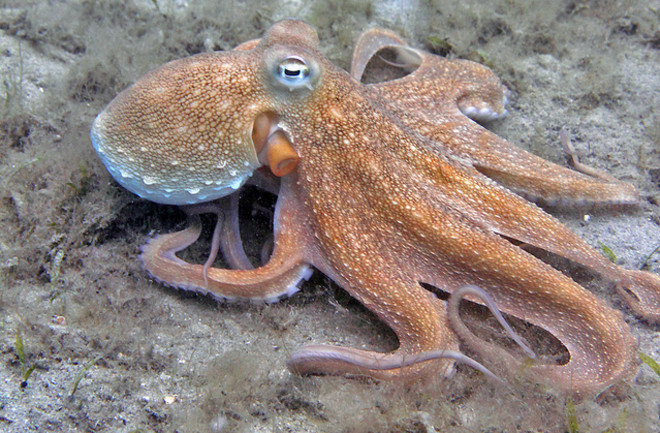Of course there's nothing ordinary about an octopus. It's the animal that showed us spinelessness doesn't have to mean a lack of smarts. But when researchers brought some octopuses into the lab to study exactly how the animals move, their findings were bizarre—both predictably and unpredictably.
Scientists at the Hebrew University of Jerusalem studied nine common octopuses (Octopus vulgaris) that fishers had scooped out of the ocean for them. Once the animals got comfortable in the lab, the scientists put them one at a time into a tank with a transparent floor. They used cameras underneath and next to the tank to meticulously track how the invertebrates crawled. The footage revealed three ways that octopuses are weird.
They can go in any direction at any time. Let's talk about octopus bodies for a moment. Like you or I, an octopus has "bilateral symmetry." This means it has a left and a right side that are mirror images of each other. If you could fold an octopus (or a human) in half on a line running between the eyes, the halves would line up. But unlike a human, an octopus also has "radial symmetry."
Read more: Inside the Brain of an Octopus
Think of a jellyfish or a sea anemone, whose parts radiate outward from a center point. The octopus arranges its eight arms this way. It's not always easy to tell which way an octopus is facing. "The soft and very flexible body of the animal can be misleading and conceal the accurate body direction," the authors write. So they coded their videos according to where the octopus's midline, running through its four left and four right legs, was pointing.
Ignore its floppy mantle; the arrow shows which way this octopus is facing. They found that octopuses can crawl in absolutely any direction, relative to where they're facing. Octopuses do seem to prefer moving at 45-degree angles, rather than directly forward or backward. The authors think this is because an octopus's eyes are on the sides of its head. It may have the worst vantage point at the border between its two fields of vision.
Despite this preference, though, octopuses are liable to go anywhere at any time. They have two orientation systems. A neck is not among the octopus's many assets. This means it can't swivel its head around on its body. To turn its face, it has to rotate its whole self. But the scientists found that octopuses control their body orientation and their movement independently. In other words, which way they're facing is irrelevant to which way they're going, and vice versa.
Read more: Through the Eye of an Octopus
They can turn their bodies around while crawling in one direction. Or they can change directions while keeping their bodies facing the same way. They have no rhythm. Octopuses crawl by pushing. They scrunch up an arm, anchor it to the ground, and then stretch it out again to propel themselves forward. The scientists tracked these "steps" to see in what order the study animals used their arms.
They saw that octopuses step without any pattern or rhythm at all. Not left-right, left-right. Not one-two-three-four. This absence of a pattern is different from how most other animals move. Actually, scratch that: it's the opposite of every known animal. Perhaps the octopus's soft body would be impossible to control with the strategies that other animals use, says author Guy Levy.
So the animals have had to evolve their own way of getting around. When octopuses swim, their locomotion is much simpler: the arms move together. But the "rhythm-less stepping," Levy says, "is different than all types of known locomotion patterns in nature." On the one hand, this is startling and new. "On the other hand, everything in the octopus is different and surprising," Levy says. "We expected surprises.”
Levy G, Flash T, & Hochner B (2015). Arm Coordination in Octopus Crawling Involves Unique Motor Control Strategies. Current biology : CB PMID: 25891406
Read More: How Do Octopuses Experience the World?

